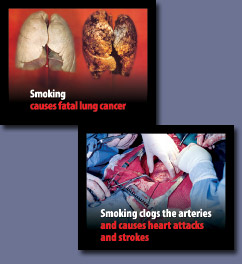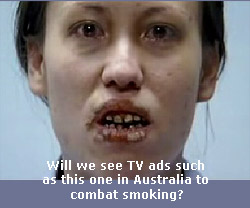 |
 |
|
The UK’s 10 million smokers should brace themselves from 1st October, when the UK will be the first country in the EU to introduce graphic picture warnings on all tobacco products. The warnings illustrate the devastating effects that tobacco can have on health. The new warnings, which include pictures of rotting teeth and lungs, throat cancer, and a ‘flaccid cigarette’, will replace the written warnings currently featured on packs, which were introduced in January 2003.
Picture warnings will begin appearing on cigarette packs from 1 October. For other tobacco products, they will start appearing from 1 October 2010. By 1st October 2009, all cigarette packs sold in the UK must feature the warnings. This is to allow enough time for introducing the new warnings and sell-through of existing stock. The following list of warnings will be used in rotation. These were selected following public consultation in 2006, from an image bank stipulated by the EU. The warnings ‘Smoking kills’ and ‘Smoking seriously harms you and others around you’ will continue to be used on the front of tobacco packs. However, despite much progress over the past ten years, which has resulted in 1.9 million fewer smokers since 19982, smoking is still the biggest killer in England and causes the premature death of over 87,000 people each year in England alone. The visual wake-up calls are expected to be even more effective than written warnings. Research suggests that warnings should be changed periodically to maintain effectiveness, and smokers are more likely to remember the damage they are doing to their health if they have seen a picture. Alan Johnson, the Health Secretary, said the drive will "potentially save thousands of lives and others will be spared the misery of watching family and friends die prematurely from smoke related illnesses." Chief Medical Officer, Sir Liam Donaldson, said: “I welcome the introduction of picture warnings on tobacco product packaging, which show smokers the grim reality of the effects smoking can have on their health. This will help to maintain the momentum of the increasing number of people who have given up smoking following England going smoke free in 2007. “Written health warnings have encouraged many smokers to stop smoking. These new stark picture warnings emphasise the harsh health realities of continuing to smoke. I hope they will make many more think hard about giving up, and get the help they need to stop smoking for good.”
“Before I was diagnosed with cancer, I felt I was invincible. I was a big strong bloke working at a trade I loved, I had a huge circle of friends and money to spend. Now I'm on invalidity benefits, and live on state handouts. I hate it and would do anything to get back into work. All this has happened to me because of smoking. I never realised you could get cancer so young. The doctors saved my life, but what I've got now is a hard struggle. I will keep on and I will fight to get better, if only for my daughter's sake.” However, The Daly Telegraph reported that Forest, the smokers' lobby group, say they are being victimised by the new rules and accuse the Government of targeting a minority group. Neil Rafferty, a spokesman for the group, said: "You could construct exactly the same argument for placing graphic images on bottles of alcohol, but because most people like to drink alcohol, the Government doesn't want to offend the majority." Last year, more than 350 thousand smokers stopped smoking with local NHS Stop Smoking Services around the country4. Smokers wishing to join them can find out more and order a free DVD explaining the different types of NHS support available to help smokers who want to quit, by calling 0800 169 0 169. You can view the full list of images here
|
 Written warnings have been a huge success, according to new figures released today by the Department of Health. Since their introduction 5 years ago, more than 90,000 smokers have been motivated by the warnings to call the NHS Smoking Helpline (0800 169 0 169).
Written warnings have been a huge success, according to new figures released today by the Department of Health. Since their introduction 5 years ago, more than 90,000 smokers have been motivated by the warnings to call the NHS Smoking Helpline (0800 169 0 169).